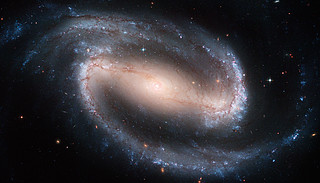The Science from the Hubble Space Telescope
Hubble is an upgradeable, space-based telescope flying almost 600 km above most of our image-distorting atmosphere.
It is designed to take high-resolution images and accurate spectra by concentrating starlight to form sharper images than is possible from the ground, where the atmospheric 'twinkling' of the stars limits the clarity of the images.
Therefore, despite its relatively modest size of 2.4 metres, Hubble is more than able to compete with ground-based telescopes that have light-collecting areas (mirrors) that are as much as 10 or 20 times larger.
Hubble's second huge advantage is its ability to observe near-infrared and ultraviolet light, which is otherwise filtered away by the atmosphere before it can reach ground-based telescopes.
Find out more about the spacecraft Hubble and see images of it in flight.
Hubble has made many contributions to science since its launch in 1990. With more than 15 500 scientific papers attributed to it, Hubble is by some measures the most productive scientific instrument ever built.
This section outlines the background to some of the key areas of research Hubble has contributed to. It is organised into the following pages:
- The Hubble Deep Fields: How Hubble has observed the furthest away galaxies and the most ancient starlight ever seen by humankind
- Age and size of the Universe: How Hubble has calculated the age of the cosmos and discovered the Universe is expanding at an ever faster rate
- The lives of stars: How Hubble has revolutionised our understanding of the birth and death of stars
- The solar neighbourhood: What Hubble has taught us about planets, asteroids and comets in our own Solar System
- Exoplanets and proto-planetary discs: How Hubble has made the first ever image of an exoplanet in visible light, and spotted planetary systems as they form
- Black Holes, Quasars, and Active Galaxies: How Hubble found black holes at the heart of all large galaxies
- Formation of stars: How Hubble observes stars as they form from huge dust clouds
- Composition of the Universe: How Hubble studied what the Universe is made of, and came to some startling conclusions
- Gravitational lenses: How astronomers use a helping hand from Einstein to increase Hubble’s range
- Europe & Hubble: How the European Space Agency and European astronomers have contributed to this international project
- Multi-messenger astronomy: Visible detections of gravitational wave Sources
To keep up to date with the latest discoveries and images from Hubble, visit the news page, or subscribe to our mailing list.
